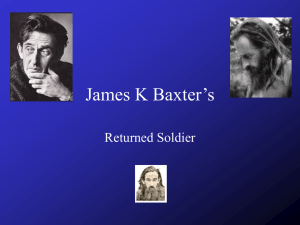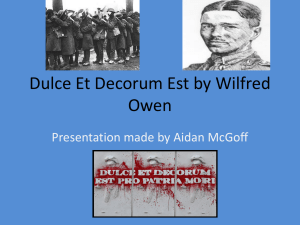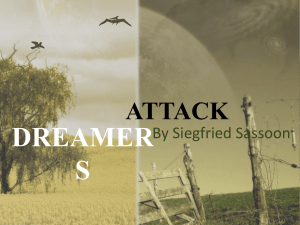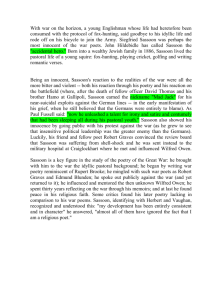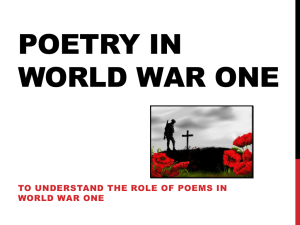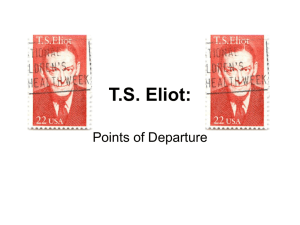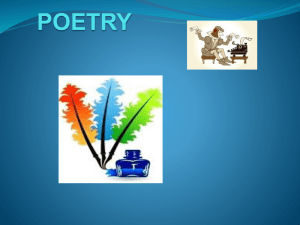WWI POETRY
advertisement
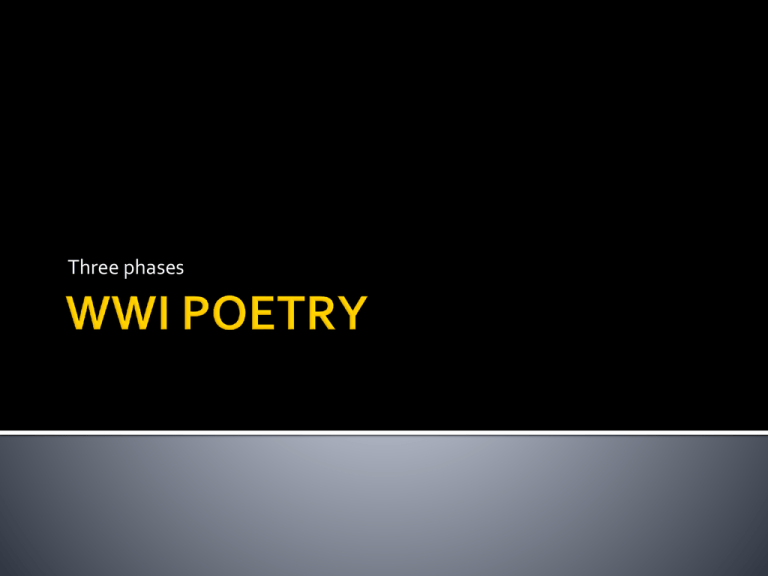
Three phases 'Poetry', Wordsworth reminds us, 'is the spontaneous overflow of powerful feelings', and there can be no area of human experience that has generated a wider range of powerful feelings than war: hope and fear; exhilaration and humiliation; hatred – not only for the enemy, but also for generals, politicians, and war-profiteers; love – for fellow soldiers, for women and children left behind, for country (often) and cause (occasionally). - John Stallworthy, Introduction to The Oxford Book of War Poetry The war was a terrible and unique experience in the history of mankind; its poetry had likewise to be unique and terrible. The 'war poets' went into the army with patriotic assurance, fought in misery, danger and muddle, and expressed their horror and protest in poetry. The poetry can be seen to fall into three phases. 1. The poetry written at the beginning of the war – 'The Illusion' – is characterised by an unreal conception of war, by lyrical, hopeful, patriotic verse glorifying fighting and welcoming death. 2. The second phase – 'The Reality' – results from the experience of war, especially after the Battle of the Somme in 1916. The changed views were reflected in new techniques: more concrete imagery and freer verse forms. 3. The third phase is 'The Aftermath', where those poets who survived look back and reflect on the cost. It is possible to appreciate the depth of the poetry of the Great War by examining the work of three poets (all officers): Rupert Brooke, Siegfried Sassoon and Wilfred Owen. Rupert Brooke epitomises the idealistic pro-war poetry of the early years. Siegfried Sassoon represents the satiric anti-war poetry of the post-1916 period. Wilfred Owen, the most complete of all the poets of WWI, would be a great poet in any company and in any era; his poetry is - as Ben Jonson said of Shakespeare - 'not for an age, but for all time'. Before WWI, war poetry was seldom written by those who had actually been to battle, and was usually heavily laden with romantic allusions to the glory of the struggles, the value of the sacrifices, and couched in traditional, flowery, abstract language. E.g. Charge of the Light Brigade, by Tennyson. Certain topics were acceptable- love, beauty, heroes, nature, patriotism, glorious death, courage- but not brutality or ugliness of war or death. To write poetry about blood gurgling from a man’s throat or a wagon wheel crunching over a dead man’s face was unthinkable before 1916. Friend=comrade Enemy=foe or the host Danger=peril Conquer=vanquish Attack=assail Dead=the fallen Die=perish Dead bodies=ashes or dust Soldier=warrior One’s death=one’s fate Warfare=strife Actions=deeds Legs and arms=limbs Contemptible=base. Blood of young men=wine Read ‘For the Fallen’ by Laurence Binyon. Highlight or underline the vocabulary that suggests battle and war are good, and any other diction that is reassuring and affirmative. What attitudes would you expect to find in poems written before the war occurred? Why? What are some romantic words used in war poetry? Give two examples of poems that reinforce this illusion? Most of the young officers and many of the poets- of the Great War had been educated in English public schools. They had learned, above else, a sense of duty and responsibility to their country, as well as self-command and discipline, the sort that could enable them to lead soldiers out of trenches and into machine gun fire. Many of these young officers were at the Front only weeks, sometimes days, after being safe in school. Twenty per cent of those who joined the forces from public school were killed. Most of the younger men who enlisted (two and a half million men signed up) were influenced by the patriotism of Rupert Brooke, and they followed him to their deaths. It is difficult to over-estimate the influence of Brooke; to his contemporaries, he expressed perfectly the idealism of 1914. This was before the Battle of Somme, before they realised what war in the Twentieth century was really like (friends drowning in mud or suffocating in gas). Men queued for hours to enlist in the army. More of a pre-war poet than a true war poet; his poetry typifies the early period, in which war is seen as noble, patriotic and chivalrous. He had romantic good-looks and an attractive personality, a literary reputation and considerable ability. When he learned he was being sent to Gallipoli, he wrote “I’ve never been quite so happy in my life, I think. Not quite so pervasively happy; like a stream flowing entirely to one end.’ On April 23rd Brooke died from blood poisoning, in the Aegean Sean on his way to Gallipoli. The importance of his poetry is less in its quality than in the impact it had. It is difficult to over-emphasise the influence of Brooke on his contemporariesHe seemed to embody the idealism of 1914. Brooke’s war experience consisted of one day of limited military action with the Hood Battalion during the evacuation of Antwerp. He died on the way to Gallipoli, so he never experienced the horrors of Flanders. Consequently, his poetry reflects an unreal conception of war. Emotional, sentimental, romantic, the sonnets are full of honour and glory; patriotism; an emphasis on England; the mystique of youth- the kind of sentiments held by many young Englishmen at the outbreak of the war. His optimism encouraged men to enlist: his poetry was used by recruiters- certainly not his intentions, which may have been to make death in war seem noble. His poetry did a great deal to win the public to war poetry, making later poets have a greater influence (Sassoon and Owen). Do activity. Analysis template Content: what is the poem about. Don’t confuse with theme. Diction: comment on what type of words are used (romantic, patriotic etc.) Device: language techniques. Mood: feeling reader gets from the words/ imagery created Tone: writer’s attitude (sincere, ironic sarcastic, childish, humorous, nostalgic). Theme: message of the poem. Content A soldier buried abroad enriches that land because he has been enriched by an English upbringing. Diction Euphemistic ‘heroic’ words: his body= “richer dust” Romantic, patriotic: “bathed by the suns of home” Device Alliteration: “Foreign field”; “Sights and sounds” Personification: his heart= “a pulse in the eternal mind…”= after life. Mood Gentle, patriotic Tone Sincere expression of devotion Theme Skilfully composed tribute to England=worth dying for. The idea of being reincarnated in the “eternal mind” Sacrifice earns immortality Brooke is innocent, even naïve about the war; the poet shows no awareness of the realities of war- which is unsurprising as he hasn’t experienced them. Some critics have suggested an unconscious arrogance- to be English is to be better than anyone else- but this is a celebration of his life, his home, his country. The poem expresses genuine patriotism and love for his country. Explain how Brooke develops the idea of patriotism in The Soldier. Comment on some of the following in your paragraph: language devices, tone, mood and connotations. Include anything else you can think of. In groups you will annotate ‘The Soldier’, by Rupert Brooke, identifying how Brooke has used figurative language to develop his themes of patriotism and purification through death. Figurate language appeals to the imagination. Refers to when a writer is saying something other than the literal meaning of the words. Metaphor Simile Personification Symbolism Allegory (poem or narrative that has a second meaning beneath the surface one) Hyperbole. 1. 2. 3. 4. 5. 6. “foreign field” Referring to the battlefield where the bodies of dead soldiers lay. This is an example of a euphemism. Brooke has use this euphemism to address the war in a lighter tone, romanticising death and masking the harsh realities of war. Poem is about the untimely death of a soldier that is undaunted by his likely demise. “there’s some corner of a foreign field that is forever England. There shall be in that earth a richer dust concealed.” Dust=English soldier. The earth will be richer as there is an English soldier beneath it (piece of England). “A dust whom England bore, shaped, made aware/Gave once her flowers to love, her ways to roam/A body of England, breathing English air. Personification of English. Reinforces Brooke’s embodiment of soldiers as not only English but England. “Some corner of a foreign field” Symbolism The field is a symbol for the simple graveyards soldiers were buried in. portraying the horrible image of dead English soldiers in shallow graves or lying on battlefields in a very light tone. “Dust” used as symbol for English soldiers dead bodies. Addressing the fatalities of war in a lighter tone. Both symbols used to lighten the poems subject. “and think this heart, all evil shed away” Brooke implies a transformation from a soldier, ordinary and human, to a cleansed soul who will live forever through England. With death for your country comes great honour and transformation into a pure soul, forever remembered for fighting for your country until the end. This idea is what inspired young men to enlist in the army and a willingness to die at war. A larger purpose can be achieved though death, an example of Brooke romanticising death and the war. Reflection of the time. It was a reassurance to the public about the war and the death occurring. Brooke’s lack of war experience influenced the demeanour of his poetry. ‘The Soldier’ gives you a small insight into the ideology of soldiers and the public, who were looking for a deeper meaning for the death and destruction occurring. Brooke felt death for your country would be rewarded in the afterlife. This would be the greatest show of devotion to your country. It’s poetry lost it’s appeal as the war progressed and the lightness in which Brookes regarded the was war recognised. Discuss the purpose of Rupert Brooke’s poem, The Soldier. Use evidence from the poem to support your answer. Intro: Introduce your argument/case and the points you will discuss. Paragraph on the imagery created through Brooke’s figurative language and how this supports your case. Paragraph on historical context and how it is reflected in the poem. (and supports your case. Conclusion: some up ideas discussed and reinforce your case. 1. rich, rarer gifts, gold, sweet wine, youth, joy, serene, immortality, holiness, love, Honour, king, royal wage, nobleness, heritage. 2. Rich, rarer gifts, gold. Sweet wine, immortality, honour, king, paid, royal wage, Nobleness, heritage. 3. “Blow out, you bugles” Bugles are blown as a call to battle. 4. No matter how poor they were before they died, dying in battle as enriched them – with such rewards as honour, nobility- and they have given these same rewards to the world, enriched the world with them. 5. Implying that death is a release from the weariness of the world, and that they chose to die. 6. Their future-work, pleasure, the happiness of “serene” old age, and having children of their own. 7. The soldiers have given up the chance of immortality in giving up the children they might have had. 8. Holiness, love, honour, and nobleness- they have made the world better, they have restored honour to it. 9. It personifies Holiness, Love, Pain, Honour and Nobleness, who now rule the earth bestowing the wealth upon their subjects like a medieval king. 10. Ironically, the resting place of the dead who have paid such a heavy price for the return of Honour. 11. Moral uprightness, honour and nobility. Links with the overall theme of ‘payment and reward’. 13. similar sense of acceptance of death; both mention the loss of the everyday pleasures. This is one of the five sonnets Brooke wrote in a series, it celebrates the sacrifice of the young men going out to die. Glorifies war and dying for ones country. A bugle is a military musical instrument used at celebrations, suggesting that this was a time to celebrate and look forward to things (the war). It symbolizes the honour brought by fighting for your country. ‘the rich Dead!’, is an important element in the opening line of the poem. It defines the dead as honourable signifying that people who will or already have died are war heroes and bring honour to the country. Why is the word Dead written with a capital letter? Suggests the importance of dying for your country. ‘These laid the world away’ (L 4) Implying that death is a release from the weariness of the world. 'gave up the years...their immortality' (L5-8) he cleverly interjects the idea that death is not without loss. Not only for the soldiers themselves who have lost their future, but also for their offspring 'who would have been' (L7) cutting off the immortal line of subsequent generations. Describe how Rupert Brooke used figurative language to create intensity in The Dead. Romantic illusions of warfare were soon shattered for men like Sassoon and Owen, who had direct and sustained experience of the hardships of trench warfare: troops pinned down by machine gun fire, often knee-deep in mud with rats and disease. The British Expeditionary force, that crossed the channel to fight the German army, was well equipped for open warfare after several years of fighting in South Africa, but wholly deficient in material for siege or trench warfare, which required hand grenades and entrenching tools. Shell-shock, desertion, the unburied remains of bodies were normal and everyday; a ‘Blighty One’ was a self-inflicted wound bad enough to get the soldier sent home to England. After the battle of Somme in 1916, the heroic days were gone forever. Tank warfare was introduced in that year, but the war finally ended not because of the superiority of one side but because of the total destruction of morale on both sides. A great gulf developed between the fighting men and the civilians back home, and between the front-line soldiers and the senior offices who gave orders from safety back at headquarters. There on the other side of the barbed wire were fellow sufferers; the soldiers felt less hostility towards the ‘enemy’ than towards the people at home who profited from the war, who were sheltered from its realities, and who remained wilfully ignorant of its horrors. The poets saw it as their responsibility to tell the terrible truth of the misery truth that was being kept from those in England by the propaganda of politicians and war profiteers. After the Somme, poetic techniques changed to reflect these changing attitudes. No longer did the Romantic and ‘poetic’ language of pre-war poetry seem relevant or appropriate. The horror the poets experienced was reflected in concrete imagery and satire, in blank and free verse, in colloquial language. Through their poems they began to question the decisions and motives of the senior officers. 1. 2. 3. 4. 5. 6. 7. 8. 9. 10. 11. 12. 13. Where was he born and what year? What did Sassoon do after leaving College? When did he enlist in the arm? What was his role in the arm? When and what was Sassoon’s first personal loss of the war? What and when was Sassoon’s second loss of the war? How did Sassoon react to this? What nick name was he given? What earned him a military cross? What battle was Sassoon wounded in the shoulder? What did this lead to? What did Robert Graves do for Sassoon? What ended Sassoon’s participation in the war? What does epigrammatic and satirical mean? Who were Sassoon’s poems aimed at? He makes great use of repetition and motifs to create the feel of the monotonousness of war, how men just kept on dying. Using the term he rather than I, making the poem universal. Any soldier could read it and apply it to themselves. Also supports the idea that war results in a loss of identity, and people are reduced to nothing more than ‘creatures’. Sassoon emphasises mankind’s infinite capacity for cruelty, ‘dazed muttering creatures’. In the fourth line the figurative effects of imagery are combined with phonological ones (assonance, alliteration and sibilance). “Tins, boxes, bottles, shapes too vague to know,” creates a very busy confused line, echoing the hectic, confused nature of the war. The magic sentence shows that you understand the link between the techniques and the writer’s ideas. You need to show that you understand the role of the writer/director. You will also need to develop ideas and include specific examples. Magic sentences make a great start to a SEXY paragraph. Authors/directors DELIBERATELY choose techniques because they feel they are the most effective way of teaching us about life/messages which go beyond the text. Siegfried Sassoon selects motifs to emphasise the stark realities of trench warfare. Rupert Brooke employs religious illusions to romanticise war and death. The poet extends the metaphor to develop this idea of the ultimate reward gained when dying for your country. Task: In pairs you will create 3 magic sentences for The Rear-Guard, by Siegfried Sassoon. Now turn each Magic sentence into a paragraph. S= topic sentence/statement E=evidence to support your statement E=explanation of your statement D= develop your paragraph by evaluating the effectiveness of the technique you discussed, relate your paragraph to today/ your life etc. (Evaluation and synthesis). I am making this statement as an act of wilful defiance of military authority, because I believe that the War is being deliberately prolonged by those who have the power to end it. I am a soldier, convinced that I am acting on behalf of soldiers. I believe that this War, on which I entered as a war of defence and liberation, has now become a war of aggression and conquest. I believe that the purpose for which I and my fellow soldiers entered upon this war should have been so clearly stated as to have made it impossible to change them, and that, had this been done, the objects which actuated us would now be attainable by negotiation. I have seen and endured the sufferings of the troops, and I can no longer be a party to prolong these sufferings for ends which I believe to be evil and unjust. I am not protesting against the conduct of the war, but against the political errors and insincerities for which the fighting men are being sacrificed. On behalf of those who are suffering now I make this protest against the deception which is being practised on them; also I believe that I may help to destroy the callous complacency with which the majority of those at home regard the contrivance of agonies which they do not, and which they have not sufficient imagination to realize. Task: Summarise the main points of Sassoon’s declaration, include any quotes you think are significant. Poem begins innocently enough with the “Good morning” greeting, although the expectation of a crisp cheerful poem is dashed with dramatic effect at the third line, when we learn that the soldiers he smiled at were mostly dead. This revelation is shockingly matter of fact, Sassoon's identification with the men who have been lost in action is emphasised in the colloquial "'em". Sassoon is saying that these are ordinary men, men who followed orders and who hardly seemed to matter in the broad scheme of political plans and policies. Why does Sassoon name the men? Explain the last line? In WWI, many men died, because of the incompetence of those in charge and Sassoon highlights that here, in this poem. What does line one reveal about the General’s mood? Why is this important. He is in a good mood, which is opposite to how the soldiers felt. The General didn’t spend anytime on the front line and wasn’t exposed to all the death and destruction, therefore he wasn’t as depressed at the soldiers. “Now the soldiers he smiled at are most of ‘em dead,” Explain. General is smiling at these men while giving orders that result in their deaths. Incompetent. “And we’re cursing his staff for incompetent swine.” Explain. The orders given by the General and his staff are getting these men killed. The General has not been on the front line and therefore doesn’t know what is in the best interest for the soldiers. Explain lines 5-6 Sarcastic tone. These line celebrate the heroism of these men, they are returning to the front line even though they know it is a futile mission, they still wish to defend their country. Line 6: Arras is a city in northern France. This city was where the front line was located throughout much of WWI. The British's attack on the Western Front was known as the Battle of Arras. Explain line 7. Bitterly ironic, Harry and Jack returned to the front line where they were killed all because they followed the generals orders. Write a paragraph discussing the purpose of Sassoon’s “The General”. 1. 2. 3. 4. Hints Start your paragraph with a Magic Sentence. Try and integrate your quotes into your sentences. Evaluate the techniques you discuss. Relate the ideas you discuss beyond the text. S= topic sentence/statement E=evidence to support your statement E=explanation of your statement D= develop your paragraph by evaluating the effectiveness of the technique you discussed, relate your paragraph to today/ your life etc. (Evaluation and synthesis). If you want to challenge yourself try and write two or three paragraphs. 1. 2. 3. 4. Neither Brooke nor Owen survived the war; Sassoon, who did, continued to be angry, continued to use poetry to criticise the war. The army, for its delays in demobilisation. The supposed ‘land fit for heroes’ that politicians promised and did not deliver. Civilians and even returned soldiers for the ease with which they seemed to forget And above all the sheer wastefulness of the four years. Early war poems are idealistic, patriotic, heroic, in the Rupert Brooke mould. Experienced the reality; was converted to a horrified satirist by the vision of waste and terror on the Western Front. Aims 1. To show the truth about the war, the other side to the propaganda and romantic beliefs that glorified war. 2. To record the true experiences of a soldier who lived with the stench, the death, the horror. 3. To expose the hypocrisy; to condemn the complacency and callousness of civilians. 4. To end the war; to criticise and condemn its conduct. Content 1. Described the horrors of war unsparingly 2. Poems often based on actual incidents 3. Made a scathing and exact attack on those at home who remained wilfully insensible to the sufferings of the soldiers at the front. Themes 1. War is destructive, waste of human life; should never have happened. 2. The horror, not the honour, of death. 3. Realistic record of the agony 4. He held the establishment responsible for prolonged suffering of the soldiers 5. His targets: politicians, generals and other high-ranking officers; those back home either profiting from the war or remaining ignorant. Approach/tone/techniques 1. Angry. 2. Direct concrete descriptions- great immediacy, hard-hitting, no glamour, illusions. 3. Piles horror on horror with deadening impact of effect of experiences. 4. Forceful and direct, and often lacking completely in subtlety and control. 5. No subtle or carefully-worded phrases; lack of niceties, yet very effective. 6. Tone: bitter, disillusioned, forceful, angry. 7. Satirical, cynical, mocking, especially of the concept that it is glorious to die for one’s country. 8. Unlike Owen, was never a conscious experimenter, but was forced by the need to capture the truth of the front line experience into using colloquial and conversational language that was new in poetry. He went to the war from an idyllic pastoral background; He began by writing war poetry reminiscent of Rupert Brooke; He spoke out publicly against the war, and yet returned to it; He influenced and mentored the then unknown Wilfred Owen; He spent 30 years reflecting on the war through his memoirs; and last he found peace in his religious faith. Wilfred Owen was tutoring in France when the war broke out. The reality of the horrors was brought home to him when he visited a hospital for the wounded; in September, 1915, he returned to England and enlisted in the Artists’ Rifles. In January, 1917, he was posted to France and saw his first action, during which he and his men were forced to hold a flooded dug-out in no-man’s land for 50 hours whilst under heavy bombardment. In march he was injured (concussion) but returned to the front-line in April. In may he was caught in a shell explosion and , when his battalion was eventually relieved, he was diagnosed as having shell-shock, and was sent to Craiglockhart Was Hospital near Edinburgh. Here he met Siegfried Sassoon who had been sent there to avoid a courtmartial (declaration against the war). Sassoon already had a reputation as a poet and agreed to look at Owen’s poems; Owen had been writing poems since he was 11. Sassoon was impressed. The in Craiglockhart, and the early part or 1918, was in many ways his most creative, and he wrote many of his poems for which he is remembered to day. Sassoon was strongly influential on him, encouraging Owen to develop a more concrete and realistic style that his conventional, imitative, romantic style, influenced by Keats. In August 1918 Owen returned to France. He was awarded the Military Cross for bravery at Amiens, but was killed on November 4 whilst attempting to lead his men across the Sambre Canal. He was 25 years old. Owen was as much angered and appalled by the war as was Sassoon, be he expressed it differently. Whereas Sassoon declared himself a conscientious objector, in the hope that a decorated hero’s protest would have some impact, Owen felt he could not express the feelings and thoughts of the ordinary soldier in his poetry unless he went back to war to share their experience. In October, 1918, he wrote to his mother, “I came out in order to help these boys- directly by leading them as well as an officer can; indirectly, by watching their sufferings that I may speak of them as well as a pleader can. I have done the first.” In 1918, Owen drafted a preface for a collection of war poems that he hoped to publish in 1919: This book is not about heroes. English poetry is not yet fit to speak of them. Nor is it about deeds, or lands, nor anything about glory, honour, might, majesty, dominion, or power, except war. Above all I am not concerned with poetry. My subject is War and the pity of War. The poetry is in the pity. Yet these elegies are to this generation in no sense consolatory. They may be to the next. All a poet can do today is warn. This is why the true poets must be truthful. If anger is the word that best sums up Sassoon’s poetry, pity is the most often applied to Owen’s. His work is more lyrical, often gentler- though he can be equally as blunt, angry and satirical and generally more subtle than Sassoon’s. He is considered the greater poet of the two, and the greatest of the war poets. All his war poems were written between August 1917 and September 1918. only 5 were published before his death. The task of all poets can be said to be imposing order onto experience and rendering it beautiful; war is a particularly ugly and disordered experience, and requires an unusually highly developed control of language for this task to be achieved. As Dominic Hibberd wrote, “Owen needed a style which would express the pity of war without substituting disgust for grief, a language which would make it possible to remember the dead at the going down of the sun without concealing the fact that they had been slaughtered ‘like cattle’.” it is his great achievement that he succeeded in doing just this. How old was Owen when the war broke out? Describe briefly what happened to Owen at the Battle of Somme. Why was he sent to Craiglockhart? What memories did Owen write about in his poetry? What was recreated in his poetry? What was the main theme in Anthem for Doomed Youth? What was Disabled a poem about? Why is Owen the most famous War poet? What does the first line describe? One soldier fails to put on what? What does the speaker see? What are some concrete descriptions? Short sharp words? What effect does this have? What effect do the words fumbling, guttering, choking, drowning… writhing have? Devices? Mood? Tone? Theme? http://www.bbc.co.uk/schools/gcsebitesize/english_literature/poetry_sli deshow/decorem/photoplayer.shtml Poem begins with striking simile, “Bent double, like old beggars under sacks”. Pants a very powerful picture of the discomfort and lack of dignity experienced by the soldiers. “Knock-kneed, coughing like hags”, the troops march away from their enemies towards the hope of a rest. “All went lame; all blind”, what does this emphasise? war spares no one. “Drunk with fatigue”, what is the effect? powerful/striking imagery of the soldiers struggling to march along. Stanza two continues vivid imagery, describing the shocking gas attack from which one soldier does not escape. The narrator imparts the experience with a tone of horror, reliving the experience as he retells it. “In all my dreams, before my helpless sight/ He plunges at me, guttering, choking, drowning”. What is the effect of the triple description? The triple description of the soldiers plight, reinforces how haunted the narrator is, it is difficult for him to find the words to describe it. “An ecstasy of fumbling”, what device is used by Owen here? What is it’s effect? the sense of panic felt at the moment the gas shells were dropped is made clear through the use of juxtaposition. “Fitting the clumsy helmets just in time… And flound’ring like a man in fire or lime.” What is the effect of using the words clumsy and flound’ring? The figurative language of stanza two refers to the indignity of combat, The use of such words as flound’ring and clumsy communicates a feeling of disorder. “As under a green sea, I saw him drowning”, how is the speaker seeing the event? The event is viewed by the speaker through the dim glass of a mask and thick cloud of gas. Also could refer to a lack of understanding, he is observing the main through the safety of his mask and feels indifferent. What is significant about the third stanza? The speaker directly addresses the audience in the third stanza, creating a more personal connection and making the imagery even more striking. What do you notice about the word choice in the third stanza? His word choice becomes more basic, indicating the height of his emotions, “If you could hear, at every jolt, the blood come gargling from the froth corrupted lungs.” “Obscene as cancer, bitter as the cud of vile, incurable sores on innocent tongues.” particularly graphic description emphasises the idea of death in war as being nothing short of gruesome. “His hanging face, like a devil’s sick of sin”, what does this imply about death? implies a sort of horror at the transformation from life to death. The poem ends with the assertion that “Dulce et decorum est pro patria mori” is a lie. To take the stance that death for your country is ghastly and unbecoming is a bold move, as it could easily come across as being unpatriotic. However Owen is not criticising his country, but the concept of war and what it does to those who are innocent. There is not a clearly defined structure to the poem, although Owen does make use of rhyme, mostly on alternate line endings. The poem opens with a description of trench life and the conditions faced by the soldiers. Then comes the gas attack, and the poem offers a graphic description of the effects of such an attack. The opening stanza is characterised by language about 'fatigue': the soldiers 'marched asleep', they 'trudge', and 'limped on'. They are 'deaf', 'lame' and 'blind'; all rather pitiful language intended to reveal the reality of war and its effects. The speaker describes a vision in a dream of a gas victim 'guttering, choking, drowning'. The listed verbs are associated with a lack of air and death. The language used in the sections depicting the gas attack is strong, representing both the anguish of the victims of the gas attack as well as the effect on those haunted by what they have seen: 'watch the white eyes writhing in his face, / His hanging face'. The repetition of the word 'face' makes it clear which element disturbs the speaker most: the transformation in the face of the victim. The use of alliteration on the 'w' sound reflects the agonised twisting of the gas victim. War transforms soldiers, breaking them physically and mentally: 'Bent double' 'Knock-kneed'. Rather than glorious men, Owen presents the soldiers as weakened old 'hags'. The experience of war is something no soldier can escape: 'In all my dreams, before my helpless sight, / He plunges at me'. The effect of gas used in World War One is communicated to the reader through Owen's use of verbs linked to death by a lack of oxygen: 'guttering, choking, drowning', 'smothering'. Owen offers the reader very graphic imagery associated with suffering, aiming to present the truth about the war experience, arguably arising from his first-hand experience of war. Owen presents the soldiers as victims who have been betrayed by those who encouraged them to go to war. He uses words such as 'innocent' and 'children' to reinforce his positive attitude to the soldiers. Owen is bitter about war and the encouragement given to go to war. He angrily refers to 'The old Lie' that dying for your country is sweet and honourable. The detailed description of a soldier dying as a result of gas attack is intended to make the reader feel discomfort, forcing him or her to confront the reality of war, something which is far from honourable or sweet. Analyse how language features made at least two of an author’s descriptions more vivid for you. Note: “Descriptions” could include descriptions of people, places, ideas: “Vivid” could mean easy to imagine, lifelike, powerful etc. Hints 1. Start your paragraphs with a Magic Sentence. 2. Try and integrate your quotes into your sentences. 3. Evaluate the techniques you discuss. 4. Relate the ideas you discuss beyond the text. S= topic sentence/statement E=evidence to support your statement E=explanation of your statement D= develop your paragraph by evaluating the effectiveness of the technique you discussed, relate your paragraph to today/ your life etc. (Evaluation and synthesis). Read poem and annotate any language devices, imagery or anything that stands out to you. What is this poem about? compares the traditional funeral rites - bells, choirs, prayers, candles - with what the soldiers get = the noise of the guns and the grief of the girls back home List all the devices Simile: those who die as cattle. Personification: monstrous anger from the guns. Metaphor: each slow dusk a drawing down of blinds. alliteration: sad shires. personification & onomatopoeia: stuttering rifles' rapid rattle/ can patter. personification, onomatopoeia & alliteration: shrill demented choirs of wailing shells Mood? contrast between the peaceful funeral rites and the harshness of death on the Front verse 1: shrill, harsh verse 2: melancholy, sorrowful Tone? Bitter anger expressed, especially through harsh diction : monstrous, rattle, mockeries, shrill, demented compassion and sorrow; the same contrast but gentler, but without the bitterness. softens in the last line, with softer consonants and longer vowels: And each slow dusk a drawing-down of blinds – a quiet, moving conclusion. Theme? laments the death of so many who die unnecessarily in violence and terror – the waste of youth and life. Even when men die honourably for their country, their bodies cannot be brought home for burial but are left like slaughtered cattle; there is no ceremony: those at home suffer silently. Expresses grief and sorrow that those who die will never have a long life (boys), nor a proper send-off. The essential paradox of the poem is that while it dismisses formal ceremonies as 'mockeries', it yet is itself a ceremony, a requiem. What is an anthem? Why did Owen give this poem this title? a song of praise. Is Owen's use ironic or sincere? Maybe both - a good discussion point. What is the main image that runs through this poem? What are 'passing-bells', 'orisons', 'palls'? Why the reference to 'drawing down of blinds'? that of the funeral. 'Orisons' are prayers; 'passing-bells' were rung when a funeral passed; a 'pall' is the cloth put over a dead body; blinds drawn in the day are a sign that there has been a death in the house How is the image developed? Contrasts between funeral rites in peacetime and the ugliness of death at the front. Prayers / sound of guns, rifles; prayers, bells, mourning voices / shells, bugles (= calling them to the army from their homes) substitutes for mourning rites - candles = eyes of other soldiers; pale faces of girls = pall; flowers = minds; blind = sun going down. [The images are those of a house in mourning: the body would lie in the front room, covered by a pall, with flowers and candles, and the blind drawn.] Underline or highlight all the words that express sounds. How do they reinforce the meaning? stuttering, rattle, patter, voice of mourning, choirs, shrill, wailing, bugles calling – they are ugly, angry sounds Use a different colour to identify all the words that have something to do with light. candles, shine, glimmers, dusk, blinds What is the effect of the simile, “who die as cattle”? Dehumanisation, cattle led to slaughter, men had been sent to war to die, doomed to die as dumb beasts. What is the effect of the personification of shells, guns and war? Brings war to live, makes it more threatening and relevant to the readers. What is the effect of “the stuttering anger of the gun”? Enhances the threat of the guns, they are angry, which is consistent with the mood or tone of the poem. Anger at the rapid death and horror of the war. Stuttering also onomatopoeia, we can hear the guns spraying bullets and killing the innocent men. ‘bugles calling from sad shires’, explain. In England at that time, areas of land and county’s were labelled shires. Owen is implying through this personification that there has been a catastrophic conglomeration of individual loss that even the land is said sad, and calling out for those that will never return. Discuss how Owen develops a theme in Anthem for a doomed youth. 1. 2. 3. 4. Hints Start your paragraph with a Magic Sentence. Try and integrate your quotes into your sentences. Evaluate the techniques you discuss. Relate the ideas you discuss beyond the text. S= topic sentence/statement E=evidence to support your statement E=explanation of your statement D= develop your paragraph by evaluating the effectiveness of the technique you discussed, relate your paragraph to today/ your life etc. (Evaluation and synthesis). If you want to challenge yourself try and write two or three paragraphs. 1. 2. 3. 4. 5. Give your partner feedback on the following criteria. Has the paragraph got a clear structure? Is the quote woven in/ integrated? Have they commented on the effectiveness of the language techniques etc.? Have they commented on the Poets intentions? Does their analysis go beyond the text? # Help them improve their writing by suggesting how they could improve on any of the above criteria. Before 1916, conventional, imitative, romantic, influenced by Keats. Influenced by Sassoon to a more concrete style: Romanticism became realism, abstraction became actuality. Aim Committed to telling the truth; less political, he was more concerned with expressing the misery and agony of the soldiers who could not speak for themselves. He opposed the war but felt obliged to be part of it. He was an efficient officer who was awarded for bravery. He came to see the war as absolutely evil in its agonies and senseless waste. On the other hand, only as a combatant could he conscientiously and effectively speak for the men who were suffering. Content Focused on the particulars of war and men involved: dirt, muddle, boredom and terror of the trench warfare. Accurate accounts of gas causalities, madness and the wounded; recreated the atmosphere of this particularly futile and unpleasant war. Not patriotic, there is no sense of the poems being about one side or the other. Themes War’s horrors and the dignity of men- war became a metaphor for precariousness of all human effort. Compassion for the doomed soldiers, anger at those responsible. Deeply felt sense of the appalling wastefulness of war, both causalities and the human spirit. SASSOON Political: attacks leaders, civilians etc. Anger, bitterness. Satirical: ironic and robust satire Sharp and forceful. Colloquial, everyday language. Blunt and unsubtle. ANGER. OWEN less political: concentrates more on compassionate studies of fighting men. Sharp sadness, melancholy. Sympathetic: compassion, mourning. Unmatched compassion for whole doomed generation. Uses biblical and religious images occasionally as points of departure: human behaviour rejecting traditional wisdom. Atmosphere of futility, waste and horror. PITY. AIMS To record realistic horrors of war; to have it stopped. Anger at war’s brutality. Compassionate studies of the circumstances of fighting men. Exposure of hypocrisy. TECHNIQUES Realistic, brutal, unheroic- harsh retelling of actual experiences. Both can be sharp, forceful, satiric. Use colloquial speech. Vivid, concrete descriptions. # Owen was influenced by Sassoon into this more direct use of language.

